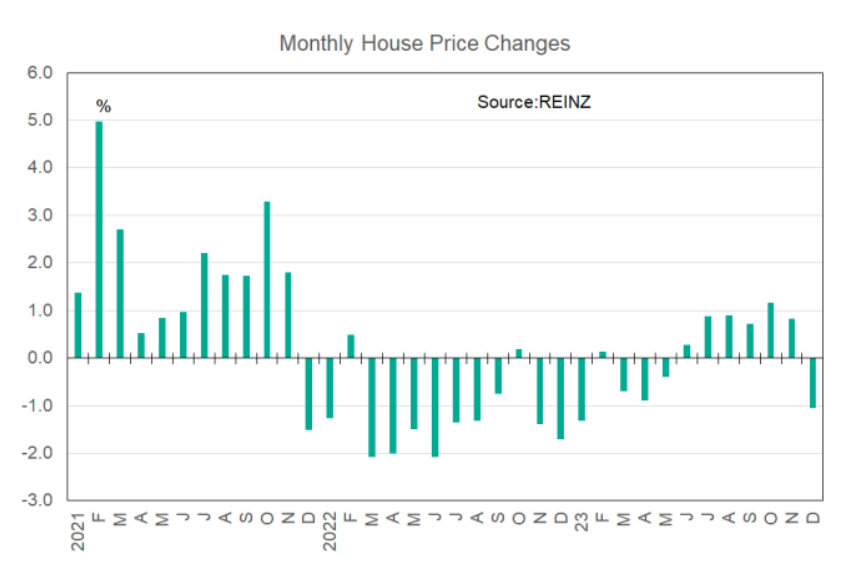Market predictions also revealed

The first issue of Regional Property Insights for 2024, curated by Tony Alexander (pictured above), independent economist, with support from First Mortgage Trust, has been released, delving into how house prices have changed in each region across New Zealand.
Since the nationwide House Price Index from REINZ commenced its upward trajectory in June of the previous year, the average house prices for all of NZ have increased by 3.8%, averaging a monthly gain of 0.5%.
The graph below “shows the monthly price changes with the December 2023 fall of 1.1% looking like a (temporary) correction to an unusually rapid pace of price rises in the previous six months,” Alexander said.

See how house prices have changed in regional housing markets.
Northland: Lagging behind with potential catch-up
Northland has experienced a unique trajectory, witnessing a fall of 1.3% in house prices since May, contrary to the national trend. However, a recent gain of 1.6% in the past three months suggested a potential catch-up, possibly influenced by the region’s close ties to Auckland’s housing market.
“One risk for Northland however has been the possibility that many Aucklanders who were planning to sell up and shift north may have already done so during the pandemic and there could now be an absence of these flows which would otherwise be happening now,” Alexander said.
Auckland: Outperforming the nation
Auckland has outperformed the national average, with a 4.2% rise in average house prices since May. The city’s recovery from pandemic-induced challenges, including a growth rate of 3% in population, positions it as a strong performer.
Alexander noted that Auckland's average house prices are currently below trend, a situation that has been influenced by the robust increase in residential construction, particularly in multi-unit complexes, in recent years. However, there is a notable decline in construction levels concurrent with strong population growth.
“The eventual price impacts seem obvious and especially so considering how far Auckland prices are out of line with their three-decade trend,” he said. “However, before one gets over-excited it pays to note that courtesy of the Unitary Plan effective from 2016 there is far greater potential for intensification within Auckland’s existing urban boundaries than was the case for all earlier years.
Bay of Plenty: Steady growth amidst national averages
While the Bay of Plenty has recorded a modest 2.3% rise in average house prices since May, the region has demonstrated consistency, closely following nationwide trends and benefiting from Auckland’s spillover effects.
At the long-term trend, Bay of Plenty house prices showed a strong increase through time, mirroring the pattern observed throughout the entire country.
“A period of above-trend price performance and levels has now completely ended, and the region does not present as being at risk of either unusually strong or unusually weak price growth compared with its long-term tendencies,” Alexander said.
Waikato: Slow upturn and dependency on Auckland
Waikato has witnessed a weaker upturn, with average house prices increasing by only 1% since May. The region's performance is closely tied to Auckland’s developments, suggesting a potential rebound as Auckland's growth influences the surrounding areas.
“Waikato region average house prices look neither high nor low compared with what their long-term trend since 1992 would suggest,” Alexander said.
Gisborne: Correction and population dynamics
Gisborne has experienced a relative price correction, with a 3.5% rise in average house prices since May. Average Gisborne house prices remained significantly elevated compared to long-term trends, due to the population boom triggered by the pandemic, Alexander said.
“Gisborne is at risk of a period of slow population growth and return of some people to the cities,” Alexander said. “This is likely to constrain the pace of house price growth in the region through 2024.”
Hawke’s Bay: Correction in progress?
Hawke’s Bay has witnessed a minor correction, with a 0.6% fall in median house prices since May. The region's earlier excess growth during the pandemic might be contributing to this correction, but the overall economic outlook remains positive.
“The fundamentals do not suggest the region is going to grossly underperform, and it is possible that the correction I have been warning about has already happened to a large degree,” Alexander said. “In the medium to long term, there is no clear reason for expecting price underperformance in the Hawke’s Bay region.”
Manawatu-Wanganui: Relative price correction underway
Since May, average house prices in Manawatu-Wanganui have increased by 1.9%, only half of the 3.8% nationwide rise. The average monthly gain since June has been 0.3%, compared to the national average of 0.5%."
The region, which initially benefited from a surge in migration, is now experiencing a relative price correction. The region’s recent underperformance might continue in the short term, but long-term prospects remain optimistic.
“The region has underperformed recently and there is a risk that this continues for the first half of 2024,” Alexander said. “A sustained period of weak price performance extending beyond 2024 looks unlikely given the economic benefits and population growth implications of the roading network improvements north of Wellington. But for now, a relative price correction is underway.”
Taranaki: Underperformance amidst stability
Taranaki has seen a 2.8% rise in average house prices since May, underperforming the national average, due in part to the absence of a population surge from the record levels of net migration inflows. However, stability in prices and an absence of pronounced trends suggest a potential for future growth.
Alexander said long-term tendencies “suggest that underperformance may only be likely if the Taranaki economy is to unusually suffer in the near future,” but claimed that such may not be the case “given some recent recovery in dairy prices, new hopes for developments in the energy sector, and the increasing tendency for foreign travellers to seek experiences outside the city hot spots.”
Wellington: Firm rise and potential challenges
Wellington has exhibited a robust rise of 7.1% in average house prices since May. Wellington has experienced average monthly house price gains of 1% since June, surpassing the national average of 0.5%. This outperformance can be attributed to factors such as weaker construction compared to other regions and a shortage of property listings.
However, potential challenges, such as affordability concerns and public sector changes, may impact the region’s future performance, Alexander said.
Nelson, Tasman, Marlborough: Tracking Averages
These regions have tracked average trends, with modest rises in average house prices since May. In the last seven months, Tasman experienced a 3.3% rise, Nelson saw a 2.9% increase, and Marlborough recorded a 1.3% uptick. While these three regions are trailing the nationwide surge, the latest data indicated an accelerating catch-up, with Marlborough showing signs of gaining momentum.
“All three small regions display current prices not sufficiently removed from where long-term trends suggest they would be to be able to offer any meaningful insight into whether risks for change lie on the slow or fast side,” Alexander said.
“Recovering tourism will benefit all three regions and affordability as especially compared with Christchurch and Wellington, alongside internal migration of an aging population, suggests there is little reason for expecting price underperformance in the next one to two years.”
West Coast: Unlikely outperformance
The West Coast has shown limited outperformance, with a 1.4% rise in average house prices since May, and a 3.3% increase in the past three months.
“Average house prices on the West Coast sit somewhat above their long-term trend,” Alexander said. “This suggests that there is little reason for expecting outperformance of the West Coast housing market this upward leg of the house price cycle…
“There is scope for weaker than normally weak population growth (actually shrinkage) on the West Coast in the near future though support from an affordability viewpoint is likely to be maintained from those retiring or able to work from home.”
Canterbury: Balanced growth
Canterbury has witnessed balanced growth, with a 3.4% rise in average house prices since May. Over the past three months, prices increased 2.2%
The region’s affordability, coupled with increased interest from those looking beyond Auckland and Wellington, suggests a positive trajectory, Alexander said.
Dunedin City/Otago: Minor outperformance possible
Dunedin City has experienced a 3.2% rise in average house prices since May, potentially positioning it for minor outperformance. The region has also seen an average monthly price gain of 0.5% since June.
The city’s population growth catch-up and recovery in foreign visitors contribute to optimistic prospects, Alexander said.
Queenstown Lakes: Unique dynamics and potential challenges
Queenstown Lakes recorded an 8.8% rise in average house prices since May. Recent REINZ data also indicated a substantial 8.8% increase in house prices in Queenstown Lakes since May, surpassing the nationwide average of 3.8%.
“The long-term trend in Queenstown prices is decidedly upward, driven by very strong population growth in an area without easy options for residential construction and high costs of doing so,” Alexander said. “Prices currently sit above trend and on that basis, one might say there is scope for underperformance.
“But the current population for Queenstown is about 4% less than would have been the case without the pandemic. There is scope for catch-up and this will place extra upward pressure on prices.
“Pressure will also come from an aging population and the strong tourism recovery.”
Southland: Keeping pace
Southland has kept pace with a 4.8% rise in average house prices since May. In the three months to December, prices were up just 0.1% versus 2.1%.While the region benefits from macroeconomic factors, including falling interest rates, limited population growth dynamics suggest stable rather than outstanding performance.
“In Southland, prices will face upward pressure from the usual macro-factors for the next couple of years such as falling interest rates and investor tax changes,” Alexander said. “But no firm scope obviously exists for relative outperformance.”
Read the full Regional Property Insights here.
Get the hottest and freshest mortgage news delivered right into your inbox. Subscribe now to our FREE daily newsletter.



